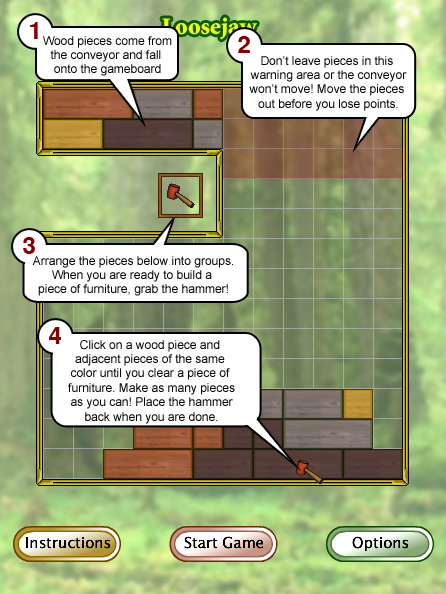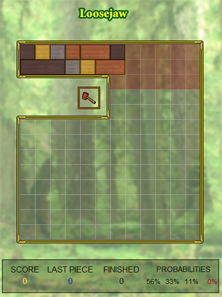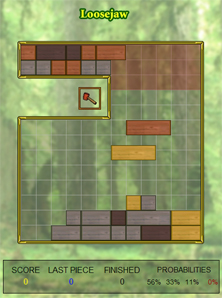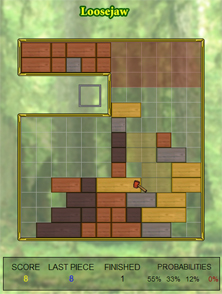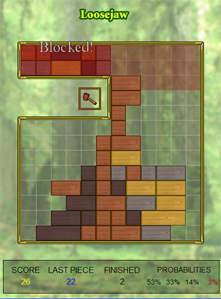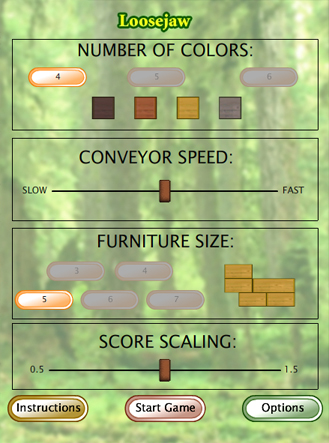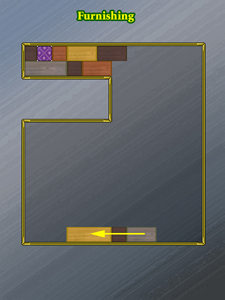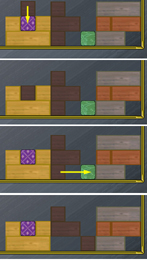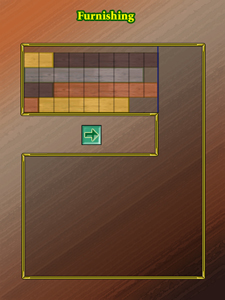GCPP:Proposal-Loosejaw
Puzzle Codename: Loosejaw
| Contact | |
| Username: | jdnx429 |
| Additional contact info: | danramarch@gmail.com |
| Project forum thread: | Discussion |
| A prototype is available for this proposal. | |
| Check it out and contribute to the design! |
Game concept
Arrange and combine the wood pieces that come sliding from the conveyor belt into furniture pieces! Create big chains for high scores.
Quick Start
Objective
Nail together five pieces of identically colored wood to create a furniture pieces. Furniture with an extra piece of upholstery earns more points!
Gameplay
The initial screen is as shown below. At the top of the screen is a conveyor belt that moves various pieces of wood to the right. Wood pieces come in four to six colors and lengths from 1 to 3 segments long. Upholstery can also arrive on the conveyor, depending on the score. Upholstery is brightly colored and servea as a bonus piece. As the pieces move to the right, they will fall down into the main board.
While the conveyor belt continues to move above, the player can slide the pieces left and right on the board. Sliding a piece from under another one, will cause the top one to fall down. It is up to the player to determine how he wants to arrange the pieces.
Play continues as such, with pieces continually falling down until the player is ready to start assembling furniture!! The player can begin assembling furniture by grabbing the hammer from the box. To create a piece of furniture, a player will grab the hammer and then click on a piece of wood. The piece of wood will turn semi-transparent, indicating that it has been selected. However, upholstery cannot be selected as the first piece in a piece of furniture.
Once the first piece is selected, adjacent pieces must be selected until a furniture piece is made. (This is by default 5 pieces but can be changed in the Options screen to as little as 3 or as high as 7). Once the required number of pieces are selected the pieces disappear.
While a player is creating a piece of furniture they are not able to slide any pieces of wood, however the conveyor will continue to move. If any pieces are left standing in the red warning area at the upper right, the conveyor pieces will turn red. If the conveyor cannot move in the next scheduled turn, it will display "Blocked" and the player will lose points:
The more pieces of furniture that are created at the same time, the higher the score. Once the hammer is placed back in the box, the count of furniture pieces is reset. Pieces with upholstery are worth bonus points but only one piece of upholstery in a piece of furniture will count towards the bonus. More than one piece of upholstery in a furniture piece will not increase the bonus.
Options
Below is the options screen from the prototype
Number of Colors: The number of different types of wood supplied by the conveyor.
Conveyor Speed: The speed of the conveyor. Be warned - the fastest speed is very hard to keep up with!
Furniture Size: The number of pieces required to clear a furniture piece.
Score Scaling: This is a multiplier which affects scoring. A higher number makes larger pieces come earlier. A lower number delays them.
Info Bar
Below is the info bar from the prototype
Score: The current score
Last Piece: The number of points the last furniture piece scored.
Finished: The number of furniture pieces made.
Probabilities: The probability that a 1-block, 2-block and 3-block piece will appear. The number in red is for Upholstery.
Scoring
Furniture Pieces
Each Furniture Piece is made of 5 pieces. Each piece can be from 1-3 segments long. Thus, each furniture piece can be from 5-15 segments.
The basic function for scoring is as follows Points = FS * (1.05)^(FS - 5)
FS = Furniture Size
The scoring for a basic furniture piece is as follows:
5 segments = 5 points
6 segments = 6.3 points
7 segments = 7.7 points
8 segments = 9.3 points
9 segments = 11.0 points
10 segments = 12.8 points
11 segments = 14.7 points
12 segments = 16.9 points
13 segments = 19.2 points
14 segments = 21.8 points
15 segments = 24.4 points
This is the base score - not including upholstery bonuses. However the largest size furniture piece cannot be made with upholstery.
Upholstery
A piece of upholstery triples the amount of points earned by a piece of furniture.
Thus a 10 segment piece with an upholstery pieces is worth (12.8 x 3.0) - 38.4 points.
Chains
A furniture piece is considered part of a chain if the hammer isn't put back into the box between completion of furniture pieces. Once the hammer is put back the chain restarts. Each furniture piece in a chain, starting with the second, gets a bonus multiplier.
2nd piece = x1.50
3rd piece = x2.00
4th piece = x2.50
5th piece = x3.00
6th piece = x4.00
7th piece = x5.00
8th piece = x6.00
..and so forth.
Thus a 7 block piece with one upholstery piece which is the 3rd piece in a chain is worth:
7.7 x 3.00 x 2.00 = 46.2 points
Variability
Different of wood colors, starting with 4 and increasing to 5 and possibly 6. Upholstery pieces become more common with larger furniture pieces made.
End criteria
Gameplay ends once 25 furniture pieces have been made.
Difficulty scaling
Initially there are onlu four different colored pieces. As the player increases in standing a fifth color is added. Further increases in standing may result in a sixth color. In addition, the conveyor speed would increase as the player increases in standing.
Crafting type
Furnishing
Known problems
Notes
Controls
left mouse button - Holding the left mouse button will select a block to be dragged along the board.
spacebar - Pressing the spacebar will advance the conveyor.
Movement
Multiple pieces can be slid at once as shown as follows. Selecting the right-most piece and sliding it left will slide all pieces to the left:
In the current prototype, however only one piece can be slid at a time. This will most likely change in the future.
Upholstery should behave differently, as it can be crushed by allowing a one-segment piece to rest on top of it or against the side of the game board. The top two images shows an upholstery piece being crushed from above. The bottom two show an upholstery piece being crushed from the side. (Also, those pieces floating should immediately fall down)
In the current prototype, upholstery cannot be crushed and behaves just like a piece of wood
Probabilites & Scaling
Wood Pieces
At the beginning of the game, there will be no upholstery pieces on the conveyor belt. Only wood pieces should be shown. The probabilities of each type of piece occurring at the initial start:
1 segment block - 56% (5/9)
2 segment block - 33% (3/9)
3 segment block - 11% (1/9)
As the game progresses and bigger and better combos are made, there is more that 2 and 3 piece blocks will appear. These are be directly tied into the score. The updated probabilities should be calculated as follows.
At the beginning of the game, there is an array with the following figures: [500, 300, 100]
The probability of any wood piece appearing on the board is determined by this array. The probability is derived by dividing the number in the array by the sum of all four numbers. In the case above, the sum is 900. The first number regulates the probability of a 1-segment block appearing, followed by 2-segment and 3-segment blocks.
The score directly influences the probabilities in this manner:
[500, 350 + 0.5 * Score * Scaling Factor, 150 + Score * Scaling Factor, 0.5 * Score * Scaling Factor]
The Score is the current score of the game. The Scaling Factor is a factor that will be used to affect the difficulty of the game. A higher number would result in larger pieces appearing much faster in the game. Thus, lower numbers are more difficult. The default, for now, is set at 1.00.
Assuming the Current Score is 200 points, the array and the probabilities are affected in this manner.
[500, 350 + 0.5 * 200 * 1.00, 150 + 200 * 1.00] = [500, 450, 350]
The sum of the items in the array is 1400, thus the probabilites are as follows:
1 segment block = 38.5% (500/1300)
2 segment block = 34.6% (450/1300)
3 segment block = 26.9% (350/1300)
Thus, the better a player scores, the more likely he is to receive larger size blocks which allows for even more points!
Upholstery
The probability of Upholstery is derived different from the Wood Pieces. Only completing chains affects the probability of Upholstery appearing.
Completing a chains adds the following to the upholstery probability:
Double = +3%
Triple = +6%
Bingo = +9%
Vegas! = +12%
Vegas!! = +15%
Vegas!!! = +18%
...and so forth.
These are cumulative, so completing a Bingo adds an 18% chance that the next piece will be an Upholstery piece.
Once an Upholstery piece appears on the conveyor, the probability is reset to 0%.
Historical Notes
In the original proposal, there was an option to allow the players to cut the boards and create more pieces for a penalty. I didn't think this was needed, but it may come back in a future iteration of the game.
Images
Original proposal, which has been revamped.
